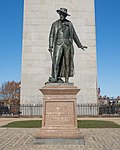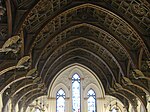The Battle of Bunker Hill was fought on June 17, 1775, during the Siege of Boston in the first stage of the American Revolutionary War. The battle is named after Bunker Hill in Charlestown, Massachusetts, which was peripherally involved. It was the original objective of both the colonial and British troops, though the majority of combat took place on the adjacent hill, which became known as Breed's Hill.
On June 13, 1775, the leaders of the colonial forces besieging Boston learned that the British were planning to send troops out from the city to fortify the unoccupied hills surrounding the city, which would give them control of Boston Harbor. In response, 1,200 colonial troops under the command of William Prescott stealthily occupied Bunker Hill and Breed's Hill. They constructed a strong redoubt on Breed's Hill overnight, as well as smaller fortified lines across the Charlestown Peninsula.
By daybreak of June 17, the British became aware of the presence of colonial forces on the Peninsula and mounted an attack against them. Two assaults on the colonial positions were repulsed with significant British casualties but the redoubt was captured on their third assault, after the defenders ran out of ammunition. The colonists retreated over Bunker Hill, leaving the British in control of the Peninsula.
The battle was a tactical victory for the British, but it proved to be a sobering experience for them; they incurred many more casualties than the Americans had sustained, including many officers. The battle had demonstrated that inexperienced militia were able to stand up to regular army troops in battle. Subsequently, the battle discouraged the British from any further frontal attacks against well defended front lines. American casualties were much fewer, although their losses included General Joseph Warren and Major Andrew McClary, the final casualty of the battle.
The battle led the British to adopt a more cautious planning and maneuver execution in future engagements, which was evident in the subsequent New York and New Jersey campaign. The costly engagement also convinced the British of the need to hire substantial numbers of Hessian auxiliaries to bolster their strength in the face of the new and formidable Continental Army.









